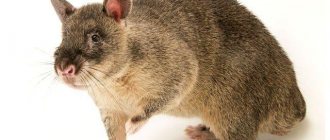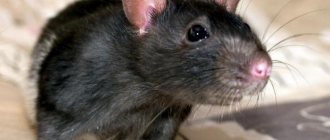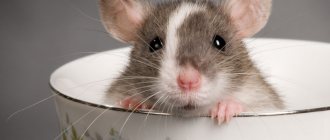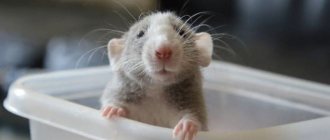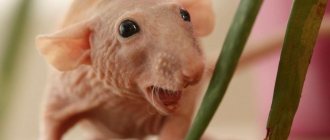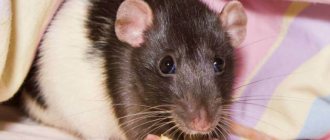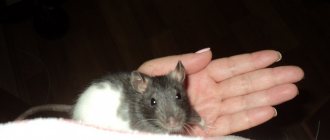- Wild animals
- >>
- Mammals
The Gambian rat is one of the largest species in the rodent family, but also one of the friendliest. Due to the large size of Gambian rats, they pose a serious threat to native species (especially nesting species) and crops, especially if they invade mainland Florida.
Origin of the species and description
Photo: Gambian rat
Gambian rats are found in central Africa, in areas south of the Sahara Desert and as far south as Zululand. This includes countries like Nigeria and others.
Gambian rats are burrowing animals. They prefer cool, dry and dark places to place their burrows as they are sensitive to heat. In their native range in Nigeria, Gambian rats are found in degraded forests, forest clearings and edges, coastal areas and sometimes near human habitations. Burrows are built near the roots of large trees, especially oil palms and the stumps of dead trees. They also inhabit areas near termite mounds, probably because these areas remain dry and cool during the rainy season.
Video: Gambian rat
This species is very common in the natural habitat of the Grassy Key area. They do not appear to live in wet scrubland or mangrove areas. They have also been reported in modified and developed residential areas. They may not need to create their own burrows in the Florida Keys, since limestone formations, trees, human habitations and trash piles are good substitutes.
The Gambian rat, also called the African giant rat, is one of the largest rats in the mouse family with an average length of about 1 m, including the tail. The Gambian rat can weigh up to 4 kg, which is comparable to a small domestic cat.
Habitat
Gumby rats live on the African mainland. They can be found in different parts of the continent, from the Sahara Desert to the “Land of the Zulu”. They live in different areas. Rats are found in arid desert areas. A colony of rodents can move across the African savanna. But most of all, mammals prefer forest areas with a moderate, cool climate.
This is interesting! Gambian rats can climb mountains. Individuals of this species were found at an altitude of 3,500 meters.
African rats constantly hide from other animals. They settle in earthen burrows and tree hollows. In mountainous areas, mammals choose rock crevices as shelter. Some groups of individuals live in populated areas, hiding in basements and burrows.
Giant rats don't travel alone. They settle in a group of individuals. The number of one colony can reach 20 mammals.
Appearance and features
Photo: What a Gambian rat looks like
Gambian rats are large rodents native to Africa. They are wild animals that can grow to the size of a small dog. Gambian rats do not make good pets, but some people still keep them in their homes.
Gambian rats are similar in size to other species of African giant rats and are often confused with this species. Gambian rats have coarse brown fur and a dark ring around the eyes, unlike African rats, which have a soft gray coat with white fur on the belly. Their long tails are scaly and they have narrow heads with small eyes. Unlike other rats, Gambian rats have cheek pouches.
Fun Fact: The main physical characteristic of Gambian rats is their large cheek pouches. These pouches can expand to enormous sizes, allowing Gambian rats to transport huge amounts of food when needed.
In captivity, these rats begin to exhibit color variations. These changes include very fine stripes and spots on the shoulders and hips, small white markings on the head such as a dot between the eyes or flames, and changes towards completely black are also found. Their most distinctive feature, common to both domestic and wild species, is their two-colored tail. Approximately two-thirds of the tail is dark, and the last third is very pale or white.
Females and males are generally the same size, with little sexual dimorphism. Gambian rats can reach sizes of up to 910 mm or more, including the tail. These rats also have a very low fat content, which may be why they are prone to catching colds. A distinctive feature of the Gambian rat is its hairless tail, which makes up almost half of the animal's total length. As a nocturnal animal, the Gambian rat has poor vision, but has an acute sense of smell and hearing.
Captivity
In Africa, marsupial rats are used as bloodhounds. Thanks to a well-developed sense of smell, animals are able to recognize mines. Rodents can smell contraband. For example, smelling drugs in bags of coffee. They are also used instead of dogs for military reconnaissance. It takes 7 months and more than 5,000 euros to train one animal.
This is interesting! Gambian rats help fight poachers in Africa. With the help of animals, tusks and scales of lizards are found, which are exported from the continent to Asia.
But mammals are suitable for more than just official duties. They are friendly and approachable. Rats love affectionate treatment. Rodents become attached to their owners and can be obedient pets.
Selection and preparation of a site
Rats, accustomed to the African climate, need a constant source of heat. In the room where the pet will be kept, the air must be heated to 20°C. It is advisable to avoid any temperature changes.
Special requirements also apply to lighting. Nocturnal animals are accustomed to soft, dim light. The sun's rays should not penetrate into the room where the animal is kept.
Cage requirements
An adult requires a spacious enclosure. The rods must be made of thick metal. The animal will bite through a thin aluminum wire in a few minutes. Cages made of plastic or wood are not suitable as they will not hold the animal.
The bottom of the enclosure must be covered with a special composition that imitates natural soil. The following fillers are suitable for this:
- dry grass;
- granulated wood shavings;
- sawdust.
The Gambia loves to hide, so the enclosure must be equipped with places where the animal will feel safe. Small houses, hanging hammocks, and grass mounds are suitable. The animal will also enjoy the labyrinth through which it can navigate inside the enclosure.
Nutrition
The pet must be fed at least twice a day. Portions must be fixed. It may seem that the Gambian rat will never get enough food, no matter how much food is offered to it. But this is a lie. The animal places food behind its cheeks and hides it in secluded places. If your pet is overfed, it may develop health problems. Despite their large size, Gambians are quite thin animals.
The rat should always have access to fresh water. The animal's diet should be made as varied as possible.
Vegetables
Fresh vegetables and herbs must be included in the menu of a pet rat. You can give this food once a day. The rats' favorite treat is sweet potatoes. It is better to give it boiled. Also, rats will not refuse other vegetables, such as carrots, zucchini, beets and cucumber. The dosage is calculated individually. If your pet has loose stools after eating vegetables, you need to reduce the daily portion. Radishes and turnips are not suitable for feeding.
Fruits
Rodents love sweet food. They feed on fruits such as apples, peaches, apricots, and watermelons. A rat will never refuse a banana. Fruits can be given every other day. If the animal begins to gain weight, the amount of fruit in the diet should be reduced. It is not advisable to include citrus fruits in the rat's menu. They can cause allergies in the animal.
Legumes
Beans, soybeans and beans cause increased gas production in rodents, causing them discomfort.
Dried peas and chickpeas can be added to food in small quantities. But only if the animal does not have digestive problems.
Seeds
Grains are the basis of rat nutrition. They should make up at least 50% of the daily diet. Food can be purchased at a pet store. The price of the mixture differs depending on the composition. It is better to choose food with minimal additives. While the bowl of ordinary ornamental rats should always be full, this is not suitable for Gambias. They need to dose their portions.
Lean boiled meat
Rats eat not only plant foods, but also animal protein. You need to give meat to the animal no more than twice a week. The amount of protein can be increased for a young individual. The meat must be boiled before serving. You can replace it with baby food or food for dogs and cats.
Low-fat cottage cheese
It is advisable to give fermented milk products to African rats several times a month. They are a source of calcium for the body. You should choose cottage cheese with a low fat content.
Some mammals of this species are lactose intolerant. In this case, you need to abandon cottage cheese in favor of dairy products without this component.
Boiled eggs
Eggs are a source of animal protein. They can be given several times a week. Both chicken and quail eggs are suitable.
Seafood
Meat and eggs in the weekly diet of the marsupial hamster rat can be replaced with boiled fish. Any variety will do. You can also use other seafood. But they also need to be boiled first.
Animal care
African rats, like all rodents, are easy to care for. It is necessary to clean the cage on time and provide the animal with constant access to water.
We must not forget that initially the giant rat was a wild steppe animal. She needs constant movement. The pet should be walked every day, providing sufficient space.
Leftover meat and fruit spoil quickly. After a day, they need to be taken out of the pet’s enclosure so that the animal does not get sick.
Character and education
Gambias are affectionate and gentle animals. They quickly get used to hands and need constant tactile contact. Their character is very calm. A rat will not bite unless it is scared.
Animals have well-developed intelligence. The rodent can be trained and taught interesting tricks.
Neighborhood of male and female
Having acquired several pets, you must take into account that they will have to be kept separately from each other. Several individuals may fight and bite.
Females and males live together only when the female is raising her male offspring. In such a situation, it is undesirable to separate the rat pups from their mother for a month. The adult male must live separately from the female and cubs, as he eats his offspring.
Where does the Gambian rat live?
Photo: Gambian hamster rat
Gambian rats can be found in a variety of habitats near man-made objects or in the forest. Their hiding places are underground and usually in the most shaded areas to keep the burrow cool and protected. As an omnivore, the Gambian rat can survive on a variety of foods, allowing it to breed in a variety of habitats where small invertebrates or vegetation are present.
Interesting fact: On its native African continent, the Gambian rat is used to detect underground mines.
Providing a good, strong, large cage for your rat at home can be challenging. It's also worth remembering that even with a large cage, rats will need to leave the cage daily to socialize and move around. These rats can start chewing everything they see around them, so be sure to keep a close eye on them when they are outside the cage. The basic requirements for the cage are minimal: the more space the Gambian rat has, the better.
Fun fact: Gambian rats live for about 5-7 years in captivity, although some have been known to live up to 8 years. The lifespan of these rats in the wild is difficult to document due to the creatures' small size and because they are so often hunted by indigenous peoples.
Now you know where Gambian rats live. Let's see what to feed them.
What does the Gambian rat eat?
Photo: Gambian pouched rat
The Gambian rat is a large, invasive animal that poses the greatest threat to crops and small native species found within Florida's borders. Many endangered species are most at risk from the Gambian rat due to its ability to compete for resources combined with high fecundity.
The Gambian rat differs from other rodents in its ability to store grain and food in its cheek pouches. This allows for more food to be consumed at one time and increases the likelihood of crop damage.
Gambian rats are omnivores and are known to consume:
- vegetables;
- insects;
- crabs;
- snails;
- palm kernels and palm fruits.
If you keep Gambian rats at home, remember that they need more protein than their smaller brothers. They are omnivores in the wild, feeding on everything from plant matter to insects and some small mammals. Animals kept as pets eat a variety of vegetables, fruits, nuts, seeds, grains and meats, as well as eggs. A specialist should be consulted about the appropriate diet for a particular animal. Rodents also like to dig into the bedding at the bottom of the cage and store food there.
Rat diet and nutritional nuances
Gambian rats are omnivores. But foods from the human table (salted, spicy, fried, etc.) are prohibited for the animal. The same applies to drinks - you can only drink water. The basis of the rat's menu should consist of the following:
- vegetables;
- fruit;
- seeds;
- nuts;
- legumes
The most important substance for the rat body is protein. Its share in nutrition is 40%. In nature, rats get their protein from insects and shellfish. To obtain protein, a pet needs to consume:
- seafood;
- boiled lean meat;
- boiled eggs;
- low-fat cottage cheese.
You need to feed your pet twice a day. The size of portions must be controlled - the animal will not refuse additional treats, but this will negatively affect its health. Therefore, it is important to ensure that your pet does not overeat.
The animal must have constant access to food and water, so food and drinking bowls must be replenished on time. If the feeder empties too quickly, you should not increase the portions for a supposedly hungry pet. The hamster rat has the habit of storing food supplies, i.e. hide food in various hiding places.
Features of character and lifestyle
Photo: African Gambian rat
Gambian rats are nocturnal animals, mainly because they have little or no tolerance for the intense heat of a typical African day. They are almost inactive during the day and come out at night in search of food. Gambian rats often use an extensive system of tunnels or hollow trees for their nests, where they rest during the day and emerge at night to search for food. These nests are often located in cool areas, providing more evidence of their heat intolerance.
Interestingly, Gambian rats find almost as much value in the act of carrying as they do in storing food. This results in intricate hoarding patterns where food is abundant at all times of the year. The pouches inside the cheeks of Gambian rats can hold more than 100 ml when filled, and this allows them to transport huge amounts of food in a short period of time. Some studies have shown that Gambian rats transport 3 kg in two and a half hours.
Gambian rats are also very good climbers and swimmers and can easily travel 2 meters. Both sexes are very territorial. Although Gambian rats tend to be solitary in the wild, females often form large groups containing many mothers and their litters, while males tend to remain solitary. These rats quickly adapt to new situations, such as captivity. Gambian rats are also known to huddle together when the temperature drops. Due to their low fat content, they do not retain heat easily.
Because Gambian rats are new to captivity, in a home environment they can be a little more unpredictable than other rats, and their temperament can vary from individual to individual. Although they can often be kept as pets, some Gambian rats remain shy or become aggressive over time. However, they can be trained, after which most rats become friendly and easy to handle.
Damage from giant rats
The Gambian hamster marsupial rat can cause great harm to humans. The animal is a carrier of monkeypox. This is a rare infection that results in body rashes and fever.
In addition, rats cause a lot of damage to property and products.
Destruction of food supplies
Gambian rodents are omnivores. They feed on a variety of fruits, nuts and seeds. Thanks to their developed sense of smell, animals easily find food. They sneak into barns and basements to eat supplies.
Damage to property
Rodents love dark, warm rooms. In cities, they choose sheds, barns and haylofts for settlement. In homes, rats live in attics and basements. Animals are always close to a food source. They choose places with stored supplies to live. For example, storage rooms. To get to food, animals gnaw their way through.
Sewer blockage
Rats can live in sewer mines. They are not afraid of moisture, and also prefer dark rooms. The sewage system is completely suitable for the comfortable existence of rodents. Animals get into them through hatches or rotten sections of pipes.
Animals use sewers to move around. They are able not only to climb horizontal surfaces, but also to climb vertical structures. Due to their large size, giant rats often get stuck in pipes, causing clogs.
The sharp teeth of rodents easily destroy any surface. They chew through plastic, corrugation, and cast iron. Thus, the sewer system is severely damaged.
Destruction of soil structure
The main place for African marsupial rats to spend the night is in earthen burrows. Animals dig passages with their paws, damaging the soil. Loosened soil dries out quickly. Because of this, plants die.
Rodents also pose a danger to ancient trees. By digging holes, they damage the root system. The trees gradually weaken and dry out. Young shoots can die completely within a few days.
Destruction of crops
One colony of African rats carries more than 20 kg of food within an hour. In agricultural areas, rodents feed on grains. They destroy huge areas of crops. In some cities, rat infestations have caused so much damage to crops that authorities have banned the import of animals. For example, in the American islands of the Florida Keys, gambia cannot be transported since 2003.
Social structure and reproduction
Photo: Baby Gambian rat
Mating in Gambian rats involves the formation of a social pair bond between one male and one female. The male usually sniffs or licks the female's urogenital areas before attempting to mate with her. Gambian rats also exhibit distinctive courtship behavior. The male and female will often stand upright and scratch each other, then chase each other until the female is ready to copulate. If the female is not receptive or rejects the male, she will bite his tail before courtship behavior begins.
Gambian rats usually breed in the summer. The estrous cycle lasts from 3 to 15 days. Interestingly, the estrous cycle is often irregular and seems to be influenced by many external factors, including the environment. Other factors include the presence of males and captivity. Females reach sexual maturity in about 6 months and typically have about 9 litters per year. The gestation period is approximately 30 to 32 days. Females are also very aggressive when giving birth to their young.
Young Gambian rats are born hairless, with their eyes and ears closed. The characteristic long tail does not show significant growth until about 30-35 days. The eyes do not open until about 21 days of development, although the young are fully furred and have open ears after about 14 days.
The female provides the most parental care, both as a source of warmth for the naked young and as a source of milk. The female also changes her eating habits before the cubs are weaned, choosing softer foods. The male, on the other hand, takes little care of the children. It is tolerant at best, and sometimes kills young individuals and eats them. This is not as common in females.
Description of appearance
By rodent standards, it has impressive dimensions:
- The body length of an adult rat reaches 90 cm along with a tail about 40-45 cm long;
- body weight ranges from 1 to 1.5 kg.
If you do not take into account the large size (the Gambian rat is one of the largest species of mouse-like animals), in appearance the animal is similar to its rat relatives. The coat is rough. The main color is brown or gray (shades may vary). The fur on the back is always darker than on the belly.
Dark circles frame the eyes. The ears are large, oval, and open. The tail is covered with scales and hairs. The appearance of males and females is no different.
Natural enemies of Gambian rats
Photo: What a Gambian rat looks like
There are no real predators that target Gambian rats in the wild. Although there have been a few recorded cases of a bird of prey or other predator eating Gambian rats, they usually gang up and are formidable opponents to potential predators. The biggest predator of Gambian rats is humans, the indigenous African population. These rats are considered a delicacy and are often hunted for food. They are considered quite tasty and are hunted and even farmed for their meat, which has led to a significant decline in the population.
Interesting Fact: Gambian rats are often used for experiments in the scientific community and provide a wealth of information about rodent physiology and behavior.
Gambian rats serve to control insect populations, but they also carry seeds of various plants when they eat the resulting fruits. Several parasitic worms live in the gastrointestinal tract of these rats, but the most common one is Strongyloides.
The study also showed an insignificant presence of tapeworms among other parasites. Other parasites include:
- xenopsylla cheopis;
- aspicularis tetraptera;
- ixodes rasus;
- ornithonyssus bacoti.
Hymenolepis is usually found in the rat's small intestine, while Aspicularis is found in the rectum and colon.
